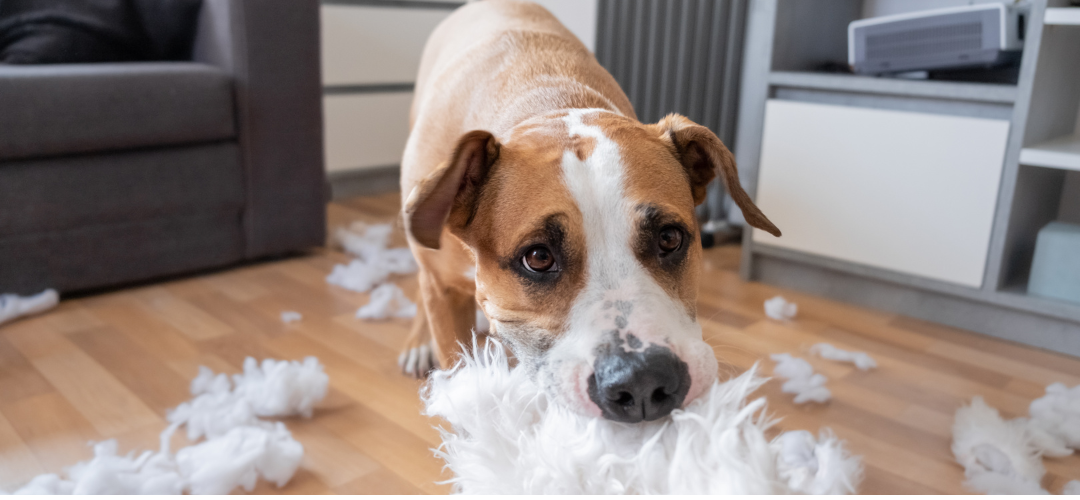
is your dog being destructive? give them a chew!
Dog Chewing Prevention: Destructive Chewing, and How to Prevent It
Dogs and especially puppies frequently chew on all sorts of objects while they’re exploring the world. (Remember, they don’t have hands — other than smell, chewing is the way most dogs interact with novel things.) Puppies chew for the same reason babies do — it’s a natural way to relieve the pain caused by incoming teeth. Adult and elderly dogs chew to keep their jaws strong and their teeth clean and happy. These are perfectly normal behaviors and all dog owners should expect them.
On the other hand, many dogs chew as an outlet to relieve boredom. Some chew compulsively to help ease boredom, anxiety, and even frustration. When you have a problem chewer, the first step toward a solution is diagnosing what’s causing the behavior.
Potential situations that cause destructive chewing separation anxiety.
If your dog suffers from separation anxiety, s/he will typically chew when left alone. (Or, if a habitual chewer, will chew most intensely when alone.) Additional symptoms of separation anxiety are:
- pacing
- whining
- barking
- general restlessness
- urination and/or defecation

Hunger
If your dog only chews on things that smell like food or are associated with food (for instance, a plastic food bowl), s/he may be chewing from hunger. This is even more likely if your dog is on a calorie-restricted diet.
Fabric Sucking
Sometimes, dogs compulsively lick, chew on, or suck at fabric. Most experts think this is a sign of premature weaning. If your dog engages in fabric sucking, and distraction isn’t easy, then it’s definitely become a problematic behavior.
Solutions for Destructive Chewing

General solutions
When you discover your dog chewing something inappropriate, offer a favorite chew toy or dog treat as an alternative. (We recommend our Nature Gnaws large bully sticks or braided bully sticks for this purpose). An edible dog chew, whether it’s a bully stick, a pig ear, or a natural bone, typically works better than a toy, simply because your dog will understand that it’s both for chewing and for eating.
Ensure your dog has several toys and chews available at all times. Instead of offering several new toys at once, offer them every two or three days. Rotating your dog’s toys also helps retain novelty and therefore your dog’s interest.
Dog-proof your house! Make certain anything valuable is stored securely. Keep dirty laundry in a hamper your dog can’t access.
If there’s an object your dog chews that you can’t move or otherwise make inaccessible, use a spray-on chewing deterrent. Expect your dog to drool excessively or even gag after tasting a deterrent. Spray the deterrent on all objects you want your dog to avoid daily, for 2-4 weeks.
Make certain your dog has ample exercise, whether it’s long walks with you, or romps in the dog park with other pets. This is especially important before you leave your dog alone for a long period (before you go to work for the day, for instance).
Teething Puppies
Just like baby humans, teething puppies chew to relieve the pain of adult teeth pushing through their gums. They need to chew. Most puppies fall in love with Nature Gnaws bully springs — the curly shape gives them lots of options to find the perfect angle that relieves the discomfort of teething.
Additionally, some trainers give teething puppies ice cubes, special freezable toys, or wet frozen washcloths to gnaw on. Cold helps ease pain in the gums. (We don’t recommend the frozen washcloth thing — a friend of ours did this and her dog grew up with a serious addiction to washcloths, towels, terry-cloth robes…) Teething puppies need to chew. Be sure to offer them an appropriate toy or chew.
Boredom
Just like us, dogs get bored — especially if you have a high-energy or high-intelligence breed (think Jack Russel terriers, basenjis, herding dogs). The best ways to relieve boredom are to offer lots of exercise and novel activities. Specific suggestions:
- Daily walks and outings (off-leash if possible, so your dog has more opportunity to explore the environment)
- Feeding meals or treats in puzzle-type toys
- A long-lasting edible chew (a bully stick of appropriate size for your dog is a great choice)
- Playing with other dogs
- Fetch games
- All types of training (the ASPCA recommends agility, flyball, and freestyle training specifically)
Stress and Frustration
Many dogs express frustration and displace stress by chewing. If your dog displays these behaviors, the best solution is simply to pay attention to the situations that cause stress. Avoid them as much as possible. When they’re unavoidable, bring along a favorite chew toy or dog chew and gently redirect your pet’s attention to the chew instead. We received this email from Elizabeth T. of Fort Lauderdale, who successfully trained her dog to avoid stress:

"Hey guys — thanks for your advice! I tried what you suggested and for the last few weeks I’ve given Izzy one of your bully sticks every time we hear thunder in the house. After just a few repetitions, she’s actually excited to hear thunder now. She runs over and wags her tail and follows me to the kitchen. When I hand her the bully stick, she takes it right to her dog bed and curls up and chews away. Thunderstorms used to absolutely terrify her, like I told you. Now she actually enjoys them. Thank you SO MUCH!!!"
Don't Do This
Destructive chewing can cause a LOT of frustration (just ask me about my sharkskin ropers from Heritage Boots in Austin sometime…). Regardless of how angry you get, the following techniques will not help and in fact may hurt your dog, or, at the very least, damage your relationship.
- Scolding or punishing after the fact. Dogs’ memories can’t connect something that happened hours or even minutes ago with punishment. If you don’t catch your dog in the act, scolding simply won’t help.
- Don’t attach a chewed item to your dog’s collar. (Remember in those old movies, where a chicken-killing dog was broken of the habit when his owner tied a dead chicken around his neck? That doesn’t work.)
- Don’t leave your dog in a crate for longer than 6 hours.
- Don’t muzzle your dog. Remember, chewing is a natural expression of a dog’s curiosity and exploration of the world. Muzzling your dog to prevent chewing would be like handcuffing your hands behind your back to stop you from biting your nails.
- Never duct tape your dog's mouth shut or over an object. Some particularly thoughtless people have duct taped their dogs’ mouths over a chewed object. Not only is this cruel, removing the tape hurts the dog a great deal. Dogs have even died from this unnecessary treatment.




